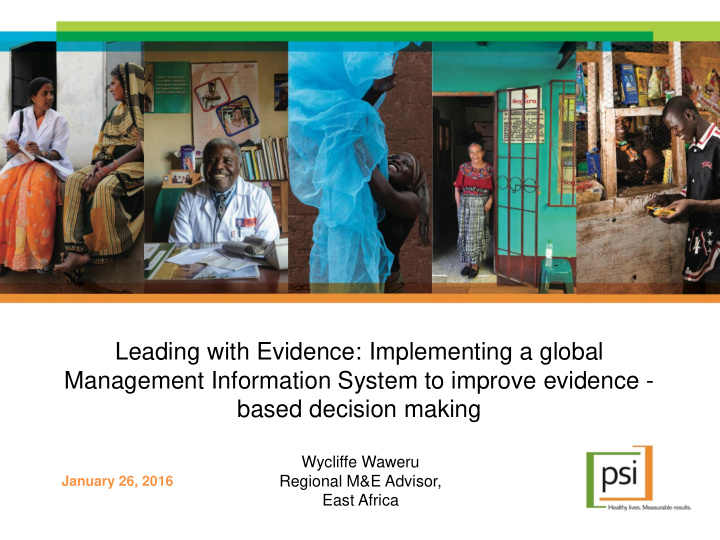



Leading with Evidence: Implementing a global Management Information System to improve evidence - based decision making Wycliffe Waweru Regional M&E Advisor, January 26, 2016 East Africa
Background: About PSI ▪ PSI makes it easier for people in the developing world to lead healthier lives and plan the families they desire by marketing affordable products and services. ▪ PSI is the leading health Social Franchising organization in the world – 33 health franchises and 10,000+ franchisees in 30 countries in Africa, Asia and Latin America – Reaches over 10 million clients annually in over 10,000 sites – In 2014, 7 Million Couple Years of Protection achieved through network
Background: Data Management challenges Multiple/parallel Management Information Systems developed and operated in-country with limited functionality and scope driven by project or donor reporting requirements causing ▪ Limited access to information by data consumers ▪ Delay in access of information ▪ Poor data visualization leading to Limited use of routine data for decision making
Intervention: Implement DHIS2 as PSI’s MIS ▪ Developed by the University of Oslo ▪ Used in 47 Countries as the National HMIS ▪ Cloud based & open source ▪ Enables collection, management and visualization of routine data
Intervention: Implement DHIS2 as PSI’s MIS ▪ Collect data via online or offline forms, with mobile capabilities (SMS, Android app) ▪ Aggregates and outputs data as reports, pivot tables, graphs or maps ▪ Customizable and shareable dashboards ▪ Enables integration of data from other business systems (e.g. Sales data from PSI’s Sales Management System, mobile phone vouchers)
Intervention Implement DHIS2 as PSI's Management Information System; designed locally and implemented globally providing Over 1,000 individual users across the organization from headquarters to health facilities with access to data through interactive dashboards leading to enhanced use of routine data for decision making
Methodology Stage Activity Conduct an assessment of routine monitoring 1. Assessment systems, processes, human resource capacity, information needs and evidence use 2. Improvement Plan Develop and implement an routine monitoring improvement plan to address issues identified Work with evidence team & program implementers to 3. System Design design the system based on information needs of country team 4. Implementation Develop system, train users, develop visualizations & dashboards & provide continuous support
DHIS2 Implementation in PSI Live Implementation In Development Cote d’Ivore Cambodia Malawi Madagascar Dominican Rep Laos Burundi Angola DRC Tanzania Mali El Salvador Nepal Mozambique Benin Ethiopia Uganda Nigeria Guatemala Pakistan Zimbabwe Cameroon Kenya Lesotho Senegal Nicaragua Vietnam
Results: Improved Evidence Divider Slide Based Decision Making
Results: Clinical Quality Assurance ▪ PSI supervisors conduct QA supervision using weighted checklists to assess quality of clinical services ▪ Results are uploaded into DHIS2 in real- time, enabling improved feedback to providers ▪ Program team can easily identify high and low performers ▪ Decision on support required & supervision frequency visits are based on findings.
Results: Contraceptive Sales ▪ Product sales managed by an ERP (Lawson) ▪ Sales data from PSI’s ERP is uploaded into DHIS2 daily for analysis and use ▪ The sales and marketing teams can easily identify areas with poor sales of contraceptives and take measures to address the poor product uptake
Results: Continuum of care ▪ PSI’s socially franchised clinics depend on IPC agents to generate service demand and refer clients ▪ DHIS2 is used to track clients from the initial contact, referral issuance, and completion of the referral loop using unique client identification codes ▪ An IPC supervisor knows in real time where, when and how many contacts and even conversions their staff are achieving
Lessons Divider Slide
Lessons ▪ Scale up implementation of DHIS2 across its network with a particular focus on using DHIS2 data to improve quality and efficiency of FP service delivery ▪ Implement a change management process so that program managers are using data for active decision making on a regular basis ▪ Accelerate implementation of clinic management systems/Electronic Medical Records at health facilities to increase efficiency and potential for integrated health services across the continuum of care
Thank you Divider Slide
Recommend
More recommend